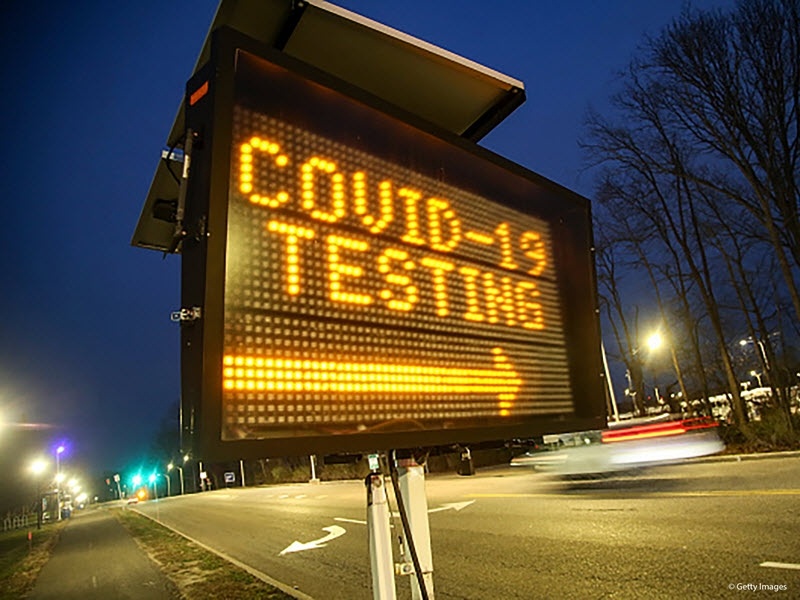The COVID-19 pandemic, caused by the SARS-CoV-2 virus, continues to grip the world. Large-scale testing is required for countries to successfully limit infections and COVID-19-related mortality rates, and is key to easing many lockdown restrictions in place globally. In this unprecedented healthcare crisis, every hour matters when it comes to identifying and preventing further spread of this human coronavirus.
The ability to detect mild and asymptomatic cases via testing enables early diagnosis and contact tracing, which is an essential step in preventing the silent spread of the virus. In an effort to meet this need, researchers across the globe are racing to develop highly accurate, efficient, and cost-effective methods for rapid testing that can be deployed in mass quantities. There are numerous assays currently being used for detection and confirmation of SARS-CoV-2 infections, along with constantly improving and creative new testing platforms coming to market rapidly. To aid in understanding the current landscape around COVID-19 diagnostic testing, CAS has produced a special report, which you can read here.
The current state of COVID-19 diagnostic testing
COVID-19 diagnostic testing is available across two main categories: tests that detect the viral genetic material (RNA) and tests that detect antibodies our bodies generate in response to the viral infection. Viral RNA tests are designed to detect the presence of SARS-CoV-2 RNA in specimens mostly collected from nasal or throat swabs from infected individuals. Antibody detection tests, on the other hand, use immunoassays to detect antibodies that may be used as indicators of current or previous infection and thus are complementary to the viral RNA tests for diagnostic purpose. More importantly, antibody tests provide information about the potential presence of acquired immunity, its duration, and strength.
These different tests play different roles in clinical and public health strategies to manage the COVID-19 pandemic and have different limitations. Most diagnostic methods for detection of viral RNA require expensive equipment, highly skilled personnel and longer wait times for results. The antibody detection assays can vary in sensitivity and specificity, and are limited by the delay time between initial virus infection and anti-viral antibody production, which can result in only a subset of SARS-CoV-2 infections giving positive results at the time of testing.
Over the past four months, rapid progress has been made in COVID-19 test development. Currently, there are over 200 diagnostic tests available from innovators across the globe . Such innovation is fueling constant improvements in testing accuracy along with higher throughputs and shorter time to results along with greater variety in point-of-care testing.
Developments in viral RNA diagnostic testing
Most viral RNA diagnostic tests rely on the reverse transcription-polymerase chain reaction (RT-PCR), which is considered to be the ‘gold standard’. RT-PCR is very sensitive and amplifies tiny amounts of viral RNA. The SARS-CoV-2 RT-PCR assays are generally run with samples collected from nasal or throat swabs, but recently developed test kits allow for convenient testing of self-collected saliva samples. Despite its advanced capabilities, RT-PCR has a few shortcomings including the fact that it requires multiple temperature changes and a longer run time. In an effort to speed up the run time associated with conventional RT-PCR, assay developers are turning to alternative amplification strategies. A primary strategy is isothermal amplification as represented by transcription-mediated amplification or TMA, which allows the entire amplification reaction to be run at a constant temperature, and in a single reaction tube. TMA is an extremely powerful technique that allows for potentially billions of RNA copies to be generated in less than an hour. A cutting-edge technology called CRISPR (Clustered Regularly Interspaced Short Palindromic Repeats) has been adapted for detection of SARS-CoV-2 viral RNA, which also uses isothermal amplification and has the potential to be deployed for rapid point-of-care tests.
Advances in anti-viral antibody detection
Antibody detection involves the use of blood or plasma samples to determine the presence of anti-SARS-CoV-2 antibodies – generally immunoglobulin M (IgM) and/or immunoglobulin G (IgG). IgM becomes detectable a few days post-infection and lasts for a couple of weeks, after which it switches to IgG, making IgM an earlier indicator of SARS-CoV-2 infection and IgG a slightly later indicator of current or prior infection (and potential post-infection immunity). These antibody detection assays generally identify either IgM or IgG antibodies targeting specific viral proteins, like the spike glycoprotein and nucleocapsid protein. They can be used to monitor disease progression in terms of the individual immune response or to track and identify patterns of past infection and possible anti-viral immunity. However, most antibody detection tests are currently in the development phase, and have only been implemented to a limited extent to date. Specific antibody testing includes enzyme-linked immunosorbent assays (ELISA), lateral flow assays, neutralization assays and specific chemosensors. ELISA is efficient, is able to test multiple samples and can be automated for increased throughput, but it varies in sensitivity and is unsuitable for point-of-care testing. Unlike ELISA, lateral flow assays are rapid, inexpensive, easy-to-use tests that are small, portable and suitable for point-of-care use, offering results in up to 30 minutes.
Neutralization assays, meanwhile, are the classic method used to determine the level of anti-viral antibodies present in a patient sample required to inhibit virus infection in cell culture conditions. Such testing requires Biosafety Level 3 laboratory facilities, but the ability to determine the strength of antibodies capable of inhibiting viral infection is crucial for both short-term therapeutics and long-term vaccine development.
New and unprecedented challenges
Rapid progress in improved diagnosis of COVID-19 has resulted in a growing number of test kits in development or available for public use. One of the major challenges associated with use of these kits is the lack of standardized evaluation protocols. There are still major hurdles associated with refining sensitivity and specificity, particularly for the antibody test kits. It also remains to be determined whether the presence of antibodies against SARS-CoV-2 is actually a valid indicator of immunity against the virus. Widespread testing is needed to mitigate and assist with controlling the COVID-19 pandemic and can potentially lead to advancements in viral epidemiology, global healthcare and beyond. Research on SARS-CoV-2 virus, the infection process and the human body’s immune response to the virus are fostering the development and innovation of better diagnostic testing. The world continues to require greater collaboration and knowledge sharing to address new and unprecedented challenges.


